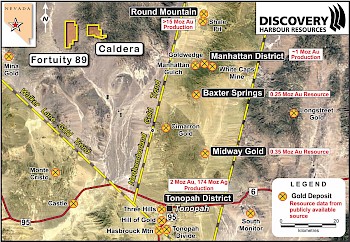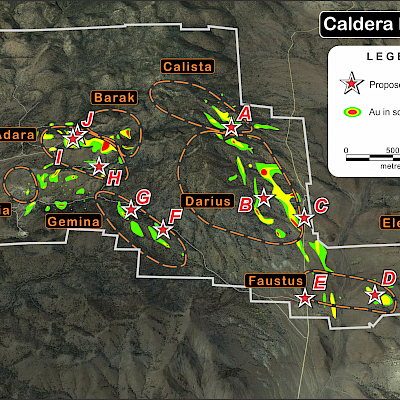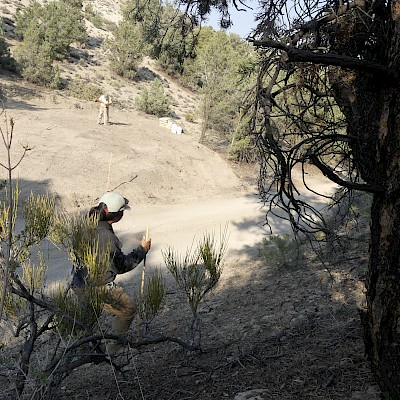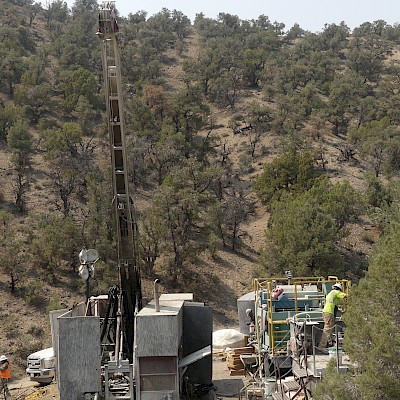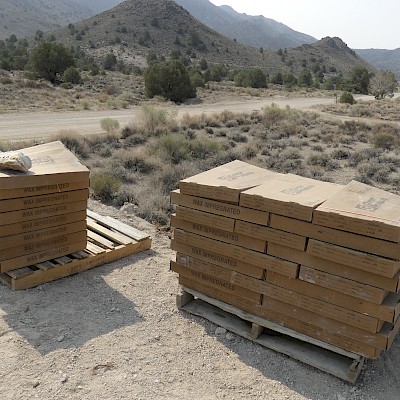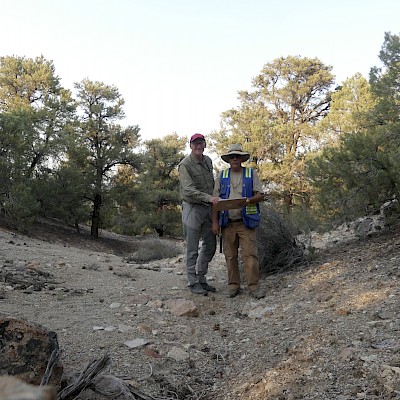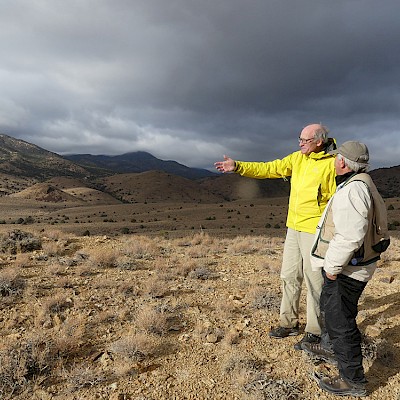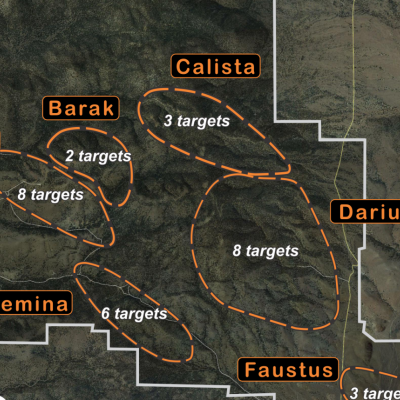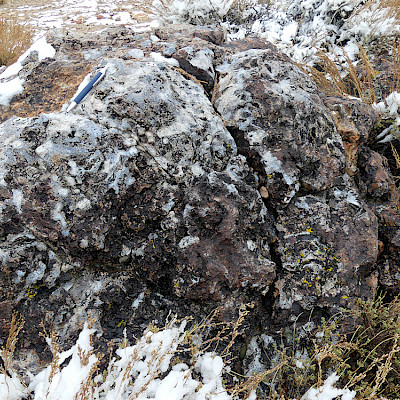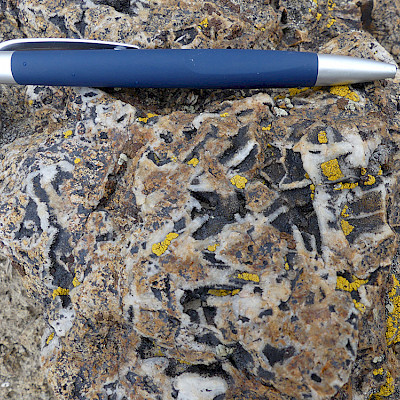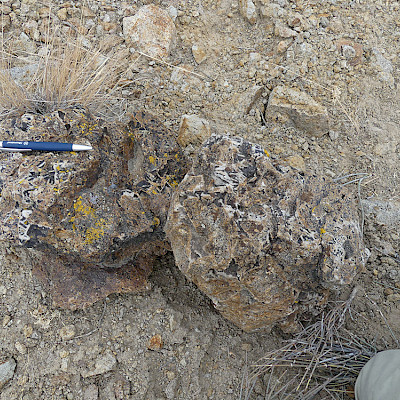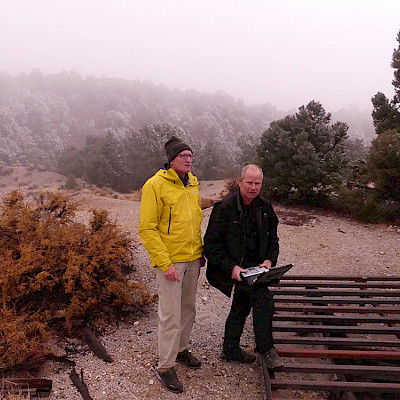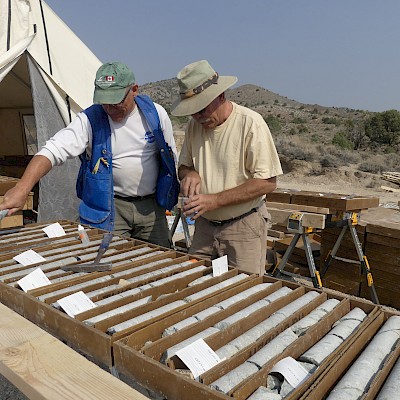Caldera
The Caldera Project – A New Approach
In late June 2021 The United States Forest Service approved Discovery Harbour’s Plan of Operations to undertake a drill program at Caldera of up to 10 epithermal gold targets. The Company plans to begin its drill program in August. Discovery Harbour acquired the Caldera Project in 2016 as a result of the potential for an overlooked low sulphidation epithermal-style deposit. Historical operators had mined high-grade veins on a small scale, while previous modern exploration had focused on shallow bulk-tonnage open-pittable targets. Discovery Harbour has compiled all the historical data, and completed detailed mapping and grid soil sampling to identify the deeper source of the high-grade, but discontinuous results at surface. The historical results on the Caldera Project include rock-chip samples as high as 193 grams per tonne (“g/t”) Au, soil samples as high as 1.3 g/t, and drill results such as 7.6 metres of 8.33 g/t Au and 3.0 metres of 37.92 g/t Au over a combined 6.5km of strike length. Historic drill holes were at vertical depths averaging less than 100 metres.
Management believes that the high grade historic intercepts represent leakage from the boiling zone (where gold grade enrichment occurs) of a low sulphidation epithermal gold deposit. The boiling zone typically occurs at approximately 300 metres depth. The dominant WNW trending strike is mineralized for at least 6.5km with a series of gold anomalies defined by surface rock and soil sampling and historical shallow drilling. Strong alteration, pathfinder elements and mineral textures associated with the low sulphidation epithermal gold model occur throughout the project area. Based on this favourable combination of factors Discovery Harbour believes Caldera has promising potential for a significant underground high-grade gold deposit.
Discovery Harbour has expanded the Caldera property several times since initially acquiring it in 2016 and it now encompasses over 30 square kilometres. The Company has developed 33 targets and submitted a Plan of Operations to drill-test up to 10 separate sites to the required depth to test the boiling zone where gold and silver would be deposited. An application for a drill permit was submitted to the United States Forest Service early in 2020 and the Company is fully funded to undertake the drill program.
Please see below for detailed description of target areas and specific drill targets.
Target Areas and Drill Target Descriptions
Discovery Harbour has identified 8 discrete areas (Adara, Barak, Calista, Darius, Electra, Faustus, Gemina and Harmonia), representing zones with the strongest combination of geological attributes which characterize the modeled gold deposit. Each area contains from 1 to 8 separate targets.
Adera (Drill Sites "H", "I" and "J")
The Adara area contains eight targets and includes the historic Golden King Mine. Historical drilling intersected sporadic high-grade shallow intercepts which are interpreted to be associated with west to northwest trending structures.
Application has been made for a permit to drill three sites in the Adara area, shown as “H”,” “I and “J” in the above figure. “I” and “J” are alternate sites to provide flexibility in the permitting process as the same target can be tested from either site.
In the immediate vicinity of “H” the following results supported its selection for drilling:
- A historical drillhole intersected 6.1m@ 3.97 g/t Au from 13.6 to 19.7m;
- Rock sampling results include assays of 9.63 g/t Au, and 65.5 g/t Au with anomalous silver, arsenic and antimony;
- Soil sampling had anomalous gold;
- Abundance of old workings and the historic Golden King mine, such that the cumulative data makes this an interesting target.
In the immediate vicinity of “I” and “J” the following results supported its selection for drilling:
Highlights of the historical drilling include the following:
| Drill Site Target | Drill Hole | Best Intercept Results |
|---|---|---|
|
I, J |
GW-5 |
1.5m @ 0.69 g/t Au, from 51.8-53.3m and 3.0m @ 37.92 g/t Au, from 102.1-105.2m |
|
I,J |
GKL-16 |
12.2m @ 0.48 g/t Au, from 79.2-91.4m and 6.1m @ 1.44 g/t Au, from 103.6-109.7m |
|
I,J |
EMC-14 |
6.1m @ 4.11 g/t Au, from 13.7-19.8m |
|
I,J |
EMC-8 |
2.2m @ 22.4 g/t Au, from 43.5-45.7m (EOH, Ended in Mineralization) |
|
I,J |
CD07-24 |
1.5m @ 9.03 g/t Au, from 22.9-24.4m |
Note: Historical drilling was reverse circulation with five-foot sample intervals.
- Rock sampling assay results included 58 g/t Au;
- Soil sampling had anomalous gold, silver and one area of anomalous mercury;
- There is an apparent bent portion of the structural development here, which is often an area prospective for gold deposition;
- The alteration in this area is chalcedony, a promising indication for gold mineralization;
- Abundance of old workings and the historic Golden King mine, such that the cumulative data makes this an interesting target.
Barak
The Barak area contains two targets based on anomalous historical drilling and brecciation in short structures identified through limited outcrop and drilling. Historical drilling intersected anomalous gold over 1.5 to 7.6m drill intercepts; however, based on Discovery Harbour’s interpretations it appears that some of the historical drilling was oriented sub parallel to the structural strike direction. The brecciated structures are associated with historical anomalous gold and silver results in rock and soil samples.
Calista (Drill Site “A”)
The Calista area contains three vein target trends, oriented northwest at 300° strike, defined by historic prospecting pits, underground workings and multi-gram gold in surface samples. The structure extends in excess of 1.5km. Historical shallow drilling (10 holes, ranging in vertical depth from 104 metres to 194 metres (“m”) in this area intersected anomalous gold, but the structures remain largely untested. The Calista area structures are strongly developed with a long strike extent, significant alteration, and associated high grade rock samples.
In order to facilitate the permitting procedure, Discovery Harbour has elected to apply for only the most easily accessible target requiring minimal road preparation within the Calista area, which is shown as “A” in the above figure.
In the immediate vicinity of “A” the following results supported its selection for drilling:
- Historical drill holes all intersected low grade gold mineralization, indicative of the gold bearing system in this area of the Caldera property;
- Drill hole GN97-3 intersected 3.3 m@3.19 g/t gold (“Au”), from 43.9-47.0m;
- Rock results from old workings and exposures include the following gold and silver assays: 8.2g/t Au, 4.93 g/t Au and 72 g/t silver (“Ag”), 15.6 g/t Au and 448 g/t Ag, 3.325 g/t Au and 203 g/t Ag, 2.98 g/t Au and 145 g/t Ag, 8.22 g/t Au and 217 g/t Ag.
- The high silver ratio is an additional interesting and promising aspect of this target;
- Historical soil sampling had anomalous gold;
- The strong, continuous structure is often comprised of silicified fault breccia material.
Details of the rock sample results over 2g/t gold are listed below (ppm is parts per million, 1 ppm=1 g/t):

Darius (Drill Sites “B” and “C”)
The Darius area contains a total of eight targets. There are a number of structural trends that, in contrast to the Calista area, trend more northerly at approximately 340 degrees.
Application has been made for a permit to drill two sites in the Darius area, shown as “B” and “C” in the above figure.
In the immediate vicinity of “B” the following results supported its selection for drilling:
- No historical drill holes. Two historical vertical drill holes in the area would not have tested this target, so that the target is untested by any historical drilling;
- There is minimal outcrop in the area. One rock sample did assay 6.24 g/t Au;
- Soil sampling had anomalous Au, Ag, as well as arsenic and mercury that were coincident with mapped structure in this area;
- Of particular interest is that the anomalous Au, Ag in soils corresponds to bladed silica after calcite, a mineral texture supportive of the gold system being intact below surface.
In the immediate vicinity of “C” the following results supported its selection for drilling:
- There is minimal outcrop in the area. One rock sample did assay 4.13 g/t Au;
- Soil sampling had a long anomalous Au anomaly, as well as arsenic, antimony and mercury;
- As with target “B”, the anomalous Au, Ag in soils corresponds to bladed silica after calcite, a mineral texture supportive of the gold system being intact below surface.
Electra
The Electra area contains two targets and is highlighted by well developed quartz veins that are exposed in historic workings and in outcrops along a prominent ridge. Historic drill hole EG-26, which appears to have been drilled subparallel to this vein possibly failing to intersect it, still intersected 6.1 metres grading 2.33 g/t gold from 65.1 to 71.2 metres. Other historical shallow drill holes also failed to adequately test the vein structures.
Discovery Harbour’s 2019 soil sampling program (see January 21, 2020 news release) covered this area and again successfully outlined multi-element anomalies including, silver, arsenic, antimony and mercury. Associated gold anomalies indicate favourable potential to the southeast beyond the current areas of known mineralization.
Faustus (Drill Sites “D” and “E”)
The Faustus area contains three targets. Targets within this area demonstrate two contrasting structural trends, one being northwesterly and the other northerly. The Faustus area also marks the southeast extent of a regional magnetic low that underlies much of the Caldera property, which Discovery Harbour has interpreted to represent the alteration zone associated with the low-sulphidation epithermal system.
Application has been made for a permit to drill two sites in the Faustus area, shown as “D” and “E” in the above figure.
In the immediate vicinity of “D” the following results supported its selection for drilling:
|
Drill Site Target |
Drill Hole |
Best Intercept Results |
|---|---|---|
|
D |
EG-26 |
6.1m @ 7.36 g/t Au, from 21.3-27.4m |
|
D |
EG-33 |
3.0m @ 5.14 g/t Au, from 9.1-12.2m |
Note: Historical drilling was reverse circulation with five-foot sample intervals.
- Poor outcrop exposure has limited any rock sampling;
- Soil sampling had anomalous gold and antimony.
- Sheeted stringer veins indicative of a mineralizing system.
- Strong silica alteration, an alteration style often associated with gold mineralization.
In the immediate vicinity of “E” the following results supported its selection for drilling:
- A historical drill hole intersected 7.6m @4.45 g/t Au from 33.5-41.1m;
- Rock sample results included the following: 48.9 g/t Au, 22.37 g/t Au, and another with 43 g/t Au with anomalous silver, arsenic and antimony;
- Soil sampling had anomalous Au, supported by the pathfinder elements arsenic, antimony and mercury;
Gemina (Drill Sites “F” and “G”)
The Gemina area is typical of a number of the defined target areas in that it possesses numerous targets based on historical workings, well defined structural zones and strongly anomalous gold results in shallow drill holes. Gemina’s six targets are over a notably long strike length that has been defined through exposures and previous drilling. The alteration zone associated with the structures is broad, characterized by a combination of quartz and chalcedony at various locations.
Application has been made for a permit to drill two sites in the Gemina area, shown as “F” and “G” in the above figure.
- Rock sampling results have produced numerous high grade assays, including 36.9 g/t and 14.5 g/t Au and a further 9 samples over 2 g/t Au;
- Soil sampling had anomalous gold, silver and the pathfinder elements arsenic and antimony;
- The targets lie at intersection of 2 structures, which is an area that could be particularly prospective for mineralization;
- There is a broad zone of quartz and chalcedony alteration.
In the immediate vicinity of “G” the following results supported its selection for drilling:
- A historical drillhole intersected 10.7m@ 1.09 g/t Au from 84.8 to 95.5m;
- Numerous rocks samples have been taken along the existing structure which are anomalous. The assays include 21.4 g/t, 19.3 g/t, 16.5 g/t, 15.2 g/t and 10.0 g/t Au and a further 16 samples over 2 g/t Au;
- Soil sampling had anomalous gold, silver and the pathfinder elements arsenic and antimony;
- The structure inflects here, which is often an area prospective for gold deposition;
- The mapped structure in this area is 500m long;
- The high silver ratio is an additional interesting and promising aspect of this target.
Details of the rocks samples taken in the Gemina area with results over 2 g/t gold are listed below (ppm is parts per million, 1 ppm=1 g/t):


Harmonia
The Harmonia area is located one kilometre west-southwest of the historic Golden King mine workings. The target is defined on the basis of clay mineralogy suggestive of low temperature acidic conditions within fine-grained sediments. These features are interpreted to represent near-surface advanced argillic alteration that could indicate the presence of a concealed epithermal zone. This potential near-surface manifestation of a deeper target is further supported by the presence of a coincident antimony-mercury-arsenic geochemical soil anomaly.
Caldera Geological Review
Caldera 2021 Drill Program
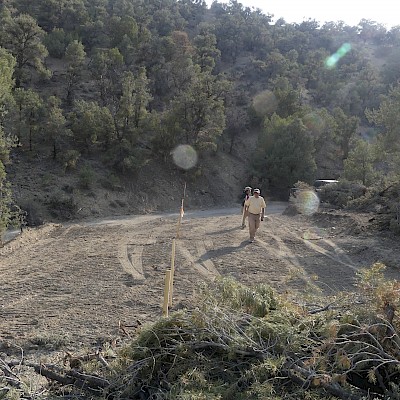

Maps and Models
Caldera Photos
Photo Gallery
Caldera 2021 Drill Program



